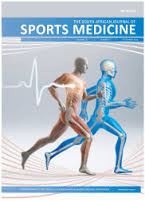Effect of the 90-second ‘Gear’ exercise programme on cardiometabolic risk factors in persons with an elevated risk of cardiovascular disease
DOI:
https://doi.org/10.17159/2078-516X/2021/v33i1a8894Abstract
Background: High-intensity interval training has recently gained popularity at improving cardiometabolic health. However, a close investigation of high-intensity interval training reveals that the exercise duration is similar to moderate-intensity continuous exercise.
Objective: To compare the effect of the time-efficient ‘Gear’ exercise programmes to traditional exercise on cardiometabolic risk factors in persons with an elevated risk of cardiovascular disease.
Methods: The study implemented a six-week, randomised controlled trial. The variables were low-density lipoprotein cholesterol, high-density lipoprotein cholesterol, triglycerides, total cholesterol, glycated haemoglobin (HbA1c), blood pressure and body composition. Forty-eight participants completed the study. Participants were randomly assigned to either the ‘Gear’ exercise programme repeated at different times during the day (GEP-DT): cycled for 90 seconds, repeated three times/day, for three days/week (n = 12); ‘Gear’ exercise programme at one point in time (GEP-OT): cycled for 90 seconds followed by 4 minutes and 30 seconds rest, repeated three times at one point in time, for three days/week (n = 14); 30 minutes of moderate-intensity continuous cycling repeated three days/week at 55-69% HRmax (n = 11); and the controls, who were encouraged not to exercise (n = 11).
A demonstration of the ‘Gear’ exercise programme can be viewed on the following link https://www.youtube.com/watch?v=KAbkRg9ex94
Results: The 90-second GEP-DT intervention reduced HbA1c post six-weeks of training (MD = 0.1±0.4, % Δ = -1.3%, d = ˗0.70). The GEP-OT group decreased blood triglycerides with a large effect size (MD = 0.6±1.3, % Δ = ˗31.9%, d = ˗0.83).
Conclusion: The novel 90-second ‘Gear’ exercise programme moderately reduced HbA1c and the 18-minute GEP-OT lowered blood triglycerides. ‘Gear’ exercise programmes will encourage future research in persons with non-communicable diseases, and it should be considered as a public health initiative to promote exercise in clinical, home and work environments.
Downloads
Published
Issue
Section
License
The South African Journal of Sports Medicine reserves copyright of the material published. The work is licensed under a Creative Commons Attribution 4.0 (CC BY 4.0) International License. Material submitted for publication in the South African Journal of Sports Medicine is accepted provided it has not been published elsewhere. The South African Journal of Sports Medicine does not hold itself responsible for statements made by the authors.
How to Cite
- Abstract 972
- PDF 845
- VIDEO 0





.png)